The university has developed innovative alternative water supplies and expanded water conservation efforts for its buildings, grounds, and residential leaseholders.
In April 2015, Governor Brown declared a state of emergency and issued an executive order to reduce water consumption statewide. In response, the State Water Resources Control Board adopted emergency water conservation regulations, which went into effect on May 18, 2015. These regulations require institutional potable (domestic) water users like Stanford to reduce consumption by 25% from a 2013 baseline, or to limit irrigation to two days per week. Stanford has complied with the regulations by limiting irrigation using potable water to two days per week, as directed by Provost Etchemendy in a June 2015 letter to the campus.
In addition to the two-days-per-week watering restrictions, Provost Etchemendy requested all users of Stanford’s nonpotable irrigation water to strive for a 25% reduction from 2013 levels. While this reduction is not required by the State Water Board, the drought has drastically reduced Stanford’s surface water supplies, resulting in greater use of groundwater in the nonpotable water system. Groundwater can be considered a “bank” that can supply water during droughts; thus, pumping should be done judiciously in order to preserve an adequate supply for future years if the drought continues, and for future decades when droughts reoccur. Many campus irrigators have already begun reduction and efficiency projects expected to achieve significant savings, and the Stanford Energy System Innovations project is expected to reduce total campus potable water use by 15%.
Results
In response to the drought, many Stanford groups reduced water use substantially in 2014 compared to 2013.
Collectively Stanford has reduced potable water use on campus 31% comparing this water year (July 2014 through June 2015) to a 2001 baseline, despite adding more than 2.5 million gross square feet to the campus buildings portfolio.
Many customer groups put forth conservation efforts in irrigation practices that resulted in significant savings to their total consumption. By carefully monitoring irrigation practices, making changes to systems, and adding weather-based irrigation controllers (WBICs), Building and Grounds Maintenance (BGM) reduced its use of potable water for irrigation by 31%. Residential and Dining Enterprises (R&DE) reduced its potable water irrigation use 28%, and School of Medicine (SOM) added additional WBICs to reduce its irrigation consumption 20%. The Stanford Campus Residential Leaseholders reduced their overall water use by 17%.
Furthermore, use of nonpotable irrigation water was voluntarily reduced by 31% through BGM, 13% by R&DE, and 11% by the Department of Athletics, Physical Education and Recreation (DAPER).
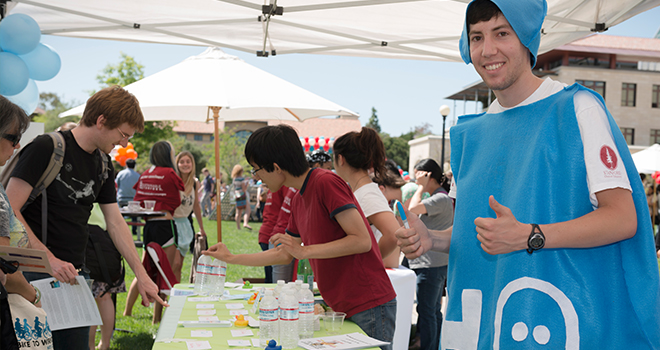
Promoting water conservation on campus
In addition to the drought-triggered reductions, Stanford expanded its Water Efficiency (WE) program, developing and implementing measures to further encourage voluntary conservation. In 2014 and 2015, WE staff sent out monthly reports to campus zones and each major campus customer group to track water usage and promote savings. The reports helped inform campus managers and residents and encourage water conservation. The greatest savings have been in areas taking an integrated approach, including open communication between area managers and WE staff, the use of smart or weather-based irrigation controllers (for landscape sites), and equipment and fixture retrofits. Additional conservation measures include updates on drought conditions on the WE website; a call for action to the campus community, which yielded hundreds of pledges to conserve water; and expanded WE rebates for campus residents and groups.
The chart below depicts Stanford’s monthly potable and nonpotable savings as a result of its water conservation efforts from 2001.
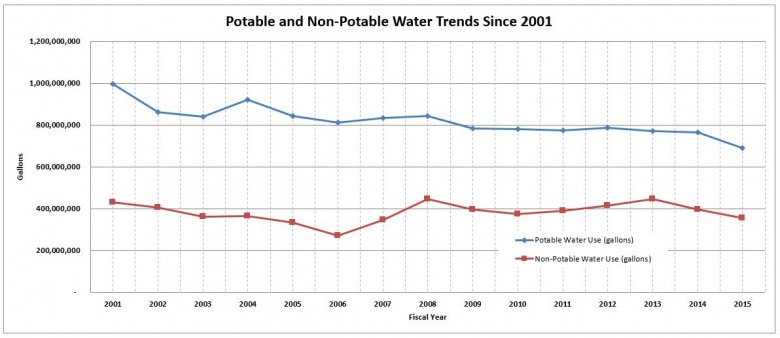
The 2003 Water Conservation Master Plan identified 14 water conservation measures for campus implementation; today, more than 20 such measures are employed. Campus domestic water use averaged 1.89 million gallons per day in the 2015 water year, the lowest average since the start of the water conservation program in 2001. Specific activities this year included the following:
Departmental Conservation
- The WE team partnered with R&DE to help fund an extensive irrigation system upgrade, including installation of 89 WBICs; over 70 flow sensors; and thousands of efficient sprinkler heads and nozzles. R&DE expects to save 33 million gallons per year from these retrofits.
- DAPER has made noteworthy strides in water conservation by replacing large areas of decorative grass with artificial turf or mulch thanks to generous donations. The WE group also partnered with DAPER to install new water-efficient column showers, which use 1.5 gallons per minute (gpm), in the Avery Aquatic Center.
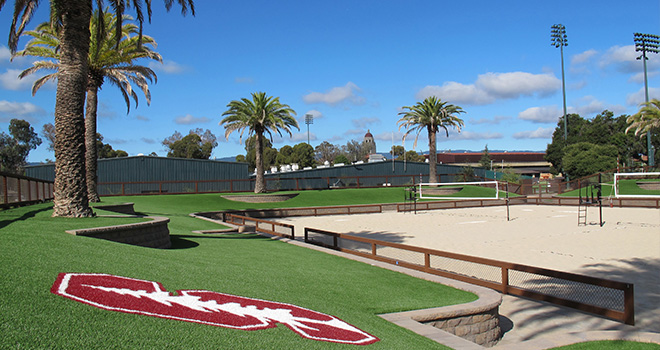
Artificial turf installed by DAPER
- SOM received rebates from the WE and Facilities Energy Management groups to purchase new devices that reduced the necessary frequency of washing lab equipment. This improvement has cut the amount of water needed for washing specific lab equipment in half.
- In 2014, the WE group partnered with the Food Service Technology Center to monitor the water and energy use of a dishwasher in Wilbur Dining Hall. After a month, the old dishwasher was removed and replaced with a new, efficient model, which was then monitored for another month and proved to be more efficient. The project highlighted the importance of best management practices in dish rooms and in product monitoring and replacements.
Customer Outreach
In an effort to further ingrain water conservation into the daily ritual of campus life, the WE group has expanded its customer outreach:
- WE staff performed landscape irrigation water audits of more than 30 residences and other campus grounds in FY 2015. The purpose of the audits was to identify leaks, eliminate irrigation runoff, and improve overall efficiency while maintaining healthy plants.
- Drought and monthly supply updates have been posted on the water efficiency website to make information and resources more easily accessible for the campus community. The website, which has proved to be a successful outreach tool, also includes information about rebates for water-efficient fixtures and landscaping.
- WE staff coordinated with campus facilities to promote the 24-hour maintenance customer service hotline as a hub for reporting water waste and leaks. Faculty, staff, students, and community members can report leaks and water waste seen on campus so they can be quickly remedied. Call (650) 723-2281 for attention to any leaking taps, toilets, or showers; misaligned irrigation (not watering plants); broken irrigation sprinklers (water shooting into the air); or excessive irrigation runoff (flowing in gutters).
- WE staff gave out free water-saving devices and other items, including over 400 shower timers, 200 water conservation bookmarks, and over 100 items such as t-shirts, pins, decals, and sponges. The WE program also provided showerheads, aerators, and toilet leak detection tablets.
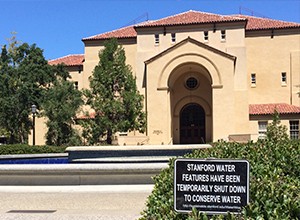
Fountains have been turned off to conserve water
- The water conservation program has maintained and updated an interactive map, featured on the WE website, which details water conservation retrofit projects from 2002 to the present. A variety of sorting parameters allow users to quickly search more than 300 indoor and outdoor projects. Clicking on the map’s icons provides details on the water-efficient equipment installed during retrofit projects, as well as the estimated water savings, when available. The map also includes general water profiles for each new building opened since 2007.
Academic Integration
Water resources remain paramount for future development in California, and thus present the opportunity for increased collaboration between operations and academics for innovative solutions to a complex issue. To this end, in 2015, a 12-person joint faculty and staff steering committee completed an extensive, four-year study of the Stanford-owned Searsville Dam and Reservoir. A significant amount of sediment has accumulated in the reservoir of the 120-year-old dam, and a plan of action is required to address this in a way that both preserves the water supply and enhances local ecology. Based on the recommendations of the committee, the university has narrowed its options to three alternatives, all of which will improve fish passage, manage accumulated and future sediment, and avoid an increase in upstream or downstream flood threats in the San Francisquito Creek watershed. The recommendations take an adaptive management approach to allow flexibility in the plan to adjust to new findings and information, and showcase the collaboration that allows the university to lead sustainability by example in its operations and landscape management.
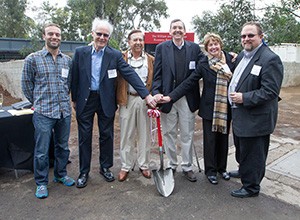
Breaking ground at the Wiliam and Cloy Codiga Resource Recovery Center
Realizing the benefits of the living laboratory that the campus provides, in March 2014 the university broke ground on the
William and Cloy Codiga Resource Recovery Center, which has the primary purpose of testing and demonstrating the scalability of promising wastewater treatment technologies and will serve as an innovation accelerator.
Looking Ahead
The WE group, in partnership with its parent department in Water Resources and Civil Infrastructure (WRCI), will continue investigating Stanford’s water resources and demands. Investigations are being conducted on Stanford’s surface water supplies (reservoirs and creeks), groundwater, and storm water capture opportunities. Based on the findings of the Searsville study that was completed in 2015, WRCI will work on developing a campus-wide Sustainable Water Management Plan.
The WE group will continue to work with students, faculty, staff, campus groups, and residents to promote efficient practices, track water savings, and implement projects that promote water conservation. Staff will continue to reach out to residential landscape water users to encourage water-saving actions and offer outdoor water surveys to customers who consume a high amount of water.





